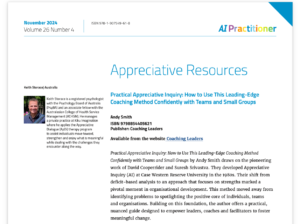Why and How to Explore Feelings

[ad_1]

Continuing the series on using the ‘Experience Cube’ in coaching! The model (quick overview here) comes from Gervase Bushe’s book Clear Leadership: Sustaining Real Collaboration and Partnership at Work, which I would say is essential reading for leaders, managers, and people who coach them. The book is about how managers can reduce misunderstanding and anxiety at work, but this particular model also makes a great coaching tool. Now, on with the article…
Interestingly, there’s no real scientific consensus on a definition of emotion or on its components, so when we talk about ‘feelings’, ‘emotions’, and ‘affect’, in each case we may be talking about slightly different things. In the Experience Cube model, Bushe distinguishes between sensations (what you feel in your body at any given moment) and emotions (which are sensations plus a judgement about your state of being – essentially, a label for what we think that sensation means), so I’ll go with that.
Emotions and Decision-Making
The first thing to note is that feelings are important. We don’t make decisions on purely rational grounds – in fact we can’t, because feelings provide motivation and are a measure of how important something is to us. Without emotion, we can’t establish priorities and so can’t make decisions.
Emotions as Information
Feelings also give us information, particularly about our relationships with other people. We could regard ‘negative’ emotions as, ideally, warning signs that carry messages; anger should tell us that our boundaries have been transgressed, guilt that we have violated our own moral standards, sadness that we have lost something or are missing something, and fear that we are in danger, or could be.
Unfortunately, this information may not be 100% reliable, because our emotional responses can sometimes be much stronger than they would need to be to give us the information, to the point where they get in the way of accessing our full capabilities. Often this is because our brains are responding not just to the realities of what’s happening now, but to an earlier, perhaps traumatic, event that the current situation somehow reminds them of. In these cases, coaching clients may need help with establishing strategies for regulating their emotions.
Emotions Influence Self-Image and Expectations
Also, emotion influences how we see the world and our place in it. The phenomenon of ‘state dependent memory’ means that it’s easier to recall a memory when you’re in a similar emotional state to how you were when the memory was laid down. So, if you’re feeling confident now, it’s easier to remember other times when you felt confident.
The strength of our belief in our own capabilities, or our belief that something will turn out well, is reinforced by our reference experiences of times when we displayed that capability, or of when we succeeded in something similar. So when it’s harder to access those reference experiences, our self-belief and expectations of success will be lower.
Reconciling Emotion and Reason
Consequently, it can be worth exploring how your coaching client feels about a particular option. If their reason is saying one thing but their feelings are saying another, is the feeling trying to tell them something that their conscious reasoning has missed? Alternatively, is the feeling an appropriate response to their current situation, or triggered by unresolved emotional baggage from a past event that it reminds them of?
Exploring the Relationship Between Sensation and Emotion
Where the client is finding their emotions problematic, it’s worth exploring the relationship between emotions and sensations. What are they actually feeling in their body when they experience the unwanted emotion? Where do they feel it in their body? Is it constant, or intermittent? Does it change over time? Does it move or stay still? What kind of sensation is it – heat, cold, prickling, pain, pressure, ‘fizziness’, or what? How intense is it?
(Here’s an NLP-based focusing exercise you can use)
What emotional ‘label’ is the client putting on these sensations? What other label could they give it? For example, is a ‘butterflies in the stomach’ feeling anxiety, or could it be excitement? The sensations for either emotion are pretty similar, so maybe it’s possible to reframe the feeling as something more productive.
What Not to Ask
Finally, here’s one emotion-related question that a coach should never ask: the stereotypical psychologist/therapist/counsellor’s question “How does that make you feel?”
Why is this counterproductive? Because it implies a simple cause and effect relationship between events and the client’s emotional response, denying the possibility of choosing a different response. To the extent that the client buys into this way of seeing things, it disempowers them and casts them as a victim (more about the downsides of the question ‘why?’ here).
I’m starting a new Practical Appreciative Inquiry facilitator training soon. If you like my materials and the way I approach things, this is pretty much the only training I’m doing these days – and it gives you a great method for coaching teams and small groups!
“Andy’s facilitation skills in the Appreciative Inquiry course are truly exceptional. With his expertise and passion for this transformative approach, he creates a dynamic and engaging learning environment that participants find enjoyable and insightful.” – Cedrick LaFleur, Author, Chief Executive LaFleur Leadership Institute, John Maxwell Team Executive Director (see the rest of this testimonial plus many others from course graduates in the ‘Recommendations’ section of my LinkedIn profile)
[ad_2]





